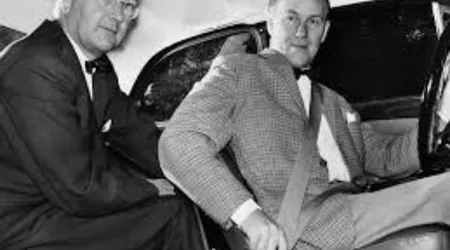The Forgotten Car Brand That Invented Seat Belts
Anúncios
Forgotten Car Brand That Invented Seat Belts!
In the fast-paced world of automotive history, some innovations shine brightly while their originators fade into obscurity.
One such story revolves around Nash Motors, a pioneering American car brand that introduced seat belts as a factory option in 1949, laying the groundwork for modern vehicle safety.
Anúncios
Though often overshadowed by later developments, Nash’s bold move challenged the status quo and set the stage for lifesaving standards we take for granted today.
This article delves into the legacy of this forgotten innovator, exploring its contributions with fresh insights and arguing why its role deserves renewed recognition.

Forgotten Car Brand That Invented Seat Belts: Summary of Topics Covered
- Who Was Nash Motors and Why Is It Considered Forgotten?
- How Did Nash Motors Pioneer Seat Belts in Automobiles?
- What Was the Initial Reception to Nash’s Seat Belt Innovation?
- Why Did Seat Belts Face Widespread Resistance at First?
- How Have Seat Belts Evolved Since Nash’s Groundbreaking Introduction?
- What Are the Proven Benefits of Seat Belts in Modern Driving?
- Frequently Asked Questions About Nash Motors and Seat Belts
++ The Hidden Message Behind Rolls-Royce Hood Ornaments
Who Was Nash Motors and Why Is It Considered Forgotten?

Nash Motors emerged as a trailblazer in the early 20th-century American auto industry, founded by Charles W.
Nash in 1916 after he left General Motors. Based in Kenosha, Wisconsin, the company quickly gained a reputation for producing reliable, affordable vehicles that appealed to middle-class families.
Moreover, Nash emphasized practical engineering over flashy designs, which helped it weather economic downturns like the Great Depression.
++ Forgotten Luxury Brands: Rediscovering the Lost Gems of Luxury
For instance, their “Weather Eye” heating system was a first-of-its-kind feature that improved driver comfort, demonstrating how Nash consistently pushed boundaries in user-focused innovations.
However, despite these achievements, Nash Motors gradually slipped from public memory after merging with Hudson Motor Car Company in 1954 to form American Motors Corporation (AMC).
This consolidation was a strategic response to intense competition from giants like Ford and Chevrolet, but it effectively diluted the Nash brand identity.
In addition, by 1957, the Nash name was phased out entirely, with production shifting to other models under AMC.
Therefore, what once was a household name became synonymous with obscurity, especially as newer brands dominated the market narrative.
Furthermore, the brand’s forgotten status stems from its lack of enduring cultural icons, unlike Ford’s Model T or Chevrolet’s Corvette.
Nash cars, while innovative, didn’t capture the same romantic allure in popular media or collector circles.
Nevertheless, this oversight undervalues Nash’s contributions, particularly in safety, where it introduced features that influenced global standards.
Isn’t it astonishing how a company that prioritized human well-being over profits could vanish so completely from collective recall?
How Did Nash Motors Pioneer Seat Belts in Automobiles?
Nash Motors didn’t just invent seat belts in the abstract; they integrated them into production vehicles as a practical safety measure amid rising road fatalities in post-World War II America.
In 1949, under the leadership of engineers focused on occupant protection, Nash offered lap-style seat belts as a factory-installed option across their lineup, including models like the Ambassador and Statesman.
++ Why Saab Once Built Cars for Airplane Pilots
This move was revolutionary because, prior to that, automobiles largely ignored passive restraints, relying instead on drivers’ reflexes during collisions.
Additionally, the design drew from earlier aviation and racing harnesses, but Nash adapted it for everyday use, making it accessible to the average consumer.
For example, their belts were simple two-point systems that anchored to the vehicle’s frame, providing basic restraint without complicating the interior layout.
Consequently, Nash installed these in approximately 40,000 vehicles that year, marking the first widespread commercial application in the U.S. auto sector.
On top of that, this innovation argued against the prevailing industry mindset that cars were inherently safe if driven carefully.
Nash’s engineers, influenced by emerging crash studies, posited that mechanical safeguards could mitigate human error.
Thus, by embedding seat belts into their manufacturing process, Nash not only pioneered the feature but also sparked a broader conversation about proactive safety engineering in automobiles.
What Was the Initial Reception to Nash’s Seat Belt Innovation?
Initially, Nash’s seat belt offering received mixed reactions from consumers and competitors alike, with many viewing it as an unnecessary add-on rather than a necessity.
Dealers reported that while some safety-conscious buyers appreciated the option, the majority opted out, leading to low adoption rates.
In fact, of the 40,000 equipped cars, anecdotal evidence suggests many owners later removed the belts themselves, perceiving them as cumbersome or implying the vehicle was prone to accidents.
Moreover, the automotive press at the time highlighted Nash’s initiative as forward-thinking, yet it didn’t translate into commercial success.
Publications like Popular Mechanics noted the potential for reducing injuries, but consumer skepticism prevailed due to a lack of awareness about crash dynamics.
Therefore, Nash’s bold step, while intelligent in hindsight, faced an uphill battle in shifting public perceptions toward embracing safety features.
Furthermore, competitors like Ford and General Motors observed Nash’s experiment closely but hesitated to follow suit immediately, fearing it might alienate buyers who prioritized style over security.
However, this reception underscored Nash’s argumentative edge: by introducing seat belts, they challenged the industry to prioritize lives over luxury, even if it meant short-term sales dips.
| Timeline of Early Seat Belt Milestones in Automotive History |
|---|
| Year |
| 1885 |
| 1903 |
| 1949 |
| 1955 |
Why Did Seat Belts Face Widespread Resistance at First?
Resistance to seat belts in the early days stemmed from a cultural mindset that viewed driving as an exercise in personal freedom, unencumbered by restraints.
Many drivers argued that belts restricted movement and comfort, making long trips feel confining.
In addition, misinformation spread that in certain crashes, being “thrown clear” of the vehicle was safer—a myth debunked by later studies but pervasive in the 1950s.
However, economic factors also played a role; adding seat belts increased production costs, which manufacturers like Nash passed on as options, deterring budget-conscious buyers.
For instance, in an era when cars were marketed as symbols of liberation, any feature suggesting danger clashed with advertising narratives.
Consequently, Nash’s innovation, though intelligent, collided with societal norms that prioritized aesthetics and speed.
On the other hand, medical professionals and safety advocates began pushing back, using data from accident reports to argue for belts’ efficacy.
Yet, this resistance highlights a broader human tendency to undervalue preventive measures until crises force change.
Analogous to wearing a helmet while cycling—initially seen as overcautious but now standard—seat belts required time and evidence to gain acceptance.
How Have Seat Belts Evolved Since Nash’s Groundbreaking Introduction?
Since Nash’s 1949 introduction, seat belts have undergone significant transformations, evolving from basic lap straps to sophisticated systems integrated with airbags and sensors.
Volvo’s Nils Bohlin advanced the concept in 1959 with the three-point belt, which distributed force across the chest and pelvis for better protection.
Therefore, Nash’s pioneer work laid the foundation, but subsequent innovations built upon it to address limitations like discomfort and effectiveness in high-speed impacts.
In addition, regulatory mandates accelerated evolution; by the 1960s, U.S.
laws required seat belts in all new cars, shifting from optional to standard. Modern belts now feature pretensioners that tighten during collisions and load limiters to prevent excessive pressure on the body.
For example, in today’s vehicles, sensors detect crash severity and adjust belt response accordingly, a far cry from Nash’s manual adjustments.
Furthermore, materials have improved, with high-strength webbing replacing early fabrics for durability.
This progression argues that Nash’s initial step was crucial, sparking a chain of advancements that continue to save lives.
Without their argumentative push for safety, the path to these enhancements might have been delayed indefinitely.
| Evolution of Seat Belt Designs |
|---|
| Design Type |
| Two-Point Lap Belt |
| Three-Point Belt |
| Pretensioner System |
| Inflatable Belt |
What Are the Proven Benefits of Seat Belts in Modern Driving?
Seat belts offer undeniable benefits, reducing the risk of fatal injuries by 45% for front-seat occupants and serious injuries by 50%, according to data from the National Safety Council.
This statistic underscores their life-saving potential, with estimates showing they prevent around 15,000 deaths annually in the U.S. alone.
Moreover, in rollover accidents, belts keep passengers inside the vehicle, minimizing ejection risks that often prove deadly.
For instance, consider a hypothetical scenario where a family sedan hydroplanes on a rainy highway; without belts, occupants might collide with the interior or be thrown out, but secured passengers absorb the impact through the restraint, emerging with minor bruises.
Another original example involves a delivery driver in urban traffic: during a sudden rear-end collision, the belt prevents whiplash by holding the torso steady, allowing quick recovery and return to work.
However, these benefits extend beyond physical protection to economic and societal gains, such as lower healthcare costs and reduced productivity losses from injuries.
Therefore, embracing seat belts isn’t just smart—it’s a testament to Nash’s visionary approach, proving that simple innovations can yield profound, long-term advantages.
Forgotten Car Brand That Invented Seat Belts: Frequently Asked Questions
| Question | Answer |
|---|---|
| Who exactly was Nash Motors, and what happened to the company? | Nash Motors was an American automaker founded in 1916, known for affordable cars. It merged into American Motors Corporation in 1954 and ceased as a brand by 1957, making it largely forgotten today. |
| Did Nash truly invent seat belts, or just introduce them? | While patents for restraints existed earlier, Nash was the first to offer them as a factory option in production cars in 1949, pioneering their widespread use in automobiles. |
| Why aren’t seat belts from Nash more celebrated? | Initial consumer resistance and the brand’s dissolution overshadowed their contribution, but modern safety standards trace back to their efforts. |
| How effective are seat belts based on current data? | They reduce fatalities by 45% and injuries by 50%, saving thousands of lives yearly and proving Nash’s innovation’s enduring value. |
| Are there any modern cars that honor Nash’s legacy? | While not directly, brands like Rambler (from AMC) carried forward some designs, and today’s safety features build on Nash’s foundational work. |
In conclusion, rediscovering Nash Motors reminds us that true innovation often comes from the underdogs, arguing for a reevaluation of automotive history.
For more details, check these current and relevant links:
